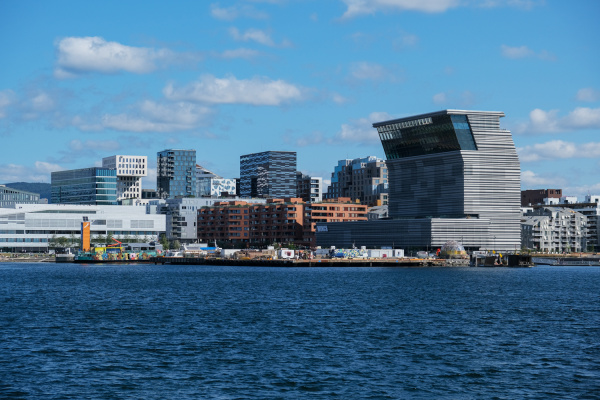Forskjell mellom versjoner av «Munch Museum»
Denne artikkelen omtaler et sted
Åpne i Oslo bykart| Linje 1: | Linje 1: | ||
| − | [[Fil:Munchmuseet Oslo JUN2019.jpg|miniatyr|600x600px|''The new Munch Museum under construction in Bjørvika. Photo: Annikdance / [https://creativecommons.org/licenses/by-sa/4.0/deed.no Creative Commons]'']]'''The Munch Museum''', Edvard Munchs plass 1, opened in 1963 in Tøyengata 53, a hundred years after the artist’s birth.The city council approved the removal of the Munch Museum from Tøyen to Bjørvika. An architectural competition held in 2009 was won by the Spanish entry JuanHerrerosArquitecto.The winning proposal ‘Lambda’, a 40-metre-high block with a lopsided section at the top, created a great deal of controversy. The final decision was taken in 2011 and the new building was completed in 2021. The museum is an independent municipal agency. | + | [[Fil:Munchmuseet Oslo JUN2019.jpg|miniatyr|600x600px|''The new Munch Museum under construction in Bjørvika. Photo: Annikdance / [https://creativecommons.org/licenses/by-sa/4.0/deed.no Creative Commons]'']] |
| + | [[Fil:MunchBjørvika.jpg|miniatyr|600x600pk|The Munch Museum situated in Bjørvika. Foto: Astrid Des Rosiers/Oslo Byleksikon]] | ||
| + | '''The Munch Museum''', Edvard Munchs plass 1, opened in 1963 in Tøyengata 53, a hundred years after the artist’s birth.The city council approved the removal of the Munch Museum from Tøyen to Bjørvika. An architectural competition held in 2009 was won by the Spanish entry JuanHerrerosArquitecto.The winning proposal ‘Lambda’, a 40-metre-high block with a lopsided section at the top, created a great deal of controversy. The final decision was taken in 2011 and the new building was completed in 2021. The museum is an independent municipal agency. | ||
The first museum building was designed by the architects Gunnar Fougner and Einar Myklebust. The latter was also the architect involved in the renovation and extension with a new pavilion in 1993, officially opened in 1994, on the 50th anniversary of Munch’s death. While the original museum was financed by the profit from the operating of Oslo Kinematografer, the later version up to 2020 has mainly comprised exhibition rooms, photo and conservation studios, offices, a library and storage space. A central feature of the museum is the lecture hall, which is also used for exhibitions, concerts, theatre performances and film shows, and in the entrance section the public will find a well-stocked museum shop and a café. | The first museum building was designed by the architects Gunnar Fougner and Einar Myklebust. The latter was also the architect involved in the renovation and extension with a new pavilion in 1993, officially opened in 1994, on the 50th anniversary of Munch’s death. While the original museum was financed by the profit from the operating of Oslo Kinematografer, the later version up to 2020 has mainly comprised exhibition rooms, photo and conservation studios, offices, a library and storage space. A central feature of the museum is the lecture hall, which is also used for exhibitions, concerts, theatre performances and film shows, and in the entrance section the public will find a well-stocked museum shop and a café. | ||
Nåværende revisjon fra 14. sep. 2021 kl. 07:50

The Munch Museum, Edvard Munchs plass 1, opened in 1963 in Tøyengata 53, a hundred years after the artist’s birth.The city council approved the removal of the Munch Museum from Tøyen to Bjørvika. An architectural competition held in 2009 was won by the Spanish entry JuanHerrerosArquitecto.The winning proposal ‘Lambda’, a 40-metre-high block with a lopsided section at the top, created a great deal of controversy. The final decision was taken in 2011 and the new building was completed in 2021. The museum is an independent municipal agency.
The first museum building was designed by the architects Gunnar Fougner and Einar Myklebust. The latter was also the architect involved in the renovation and extension with a new pavilion in 1993, officially opened in 1994, on the 50th anniversary of Munch’s death. While the original museum was financed by the profit from the operating of Oslo Kinematografer, the later version up to 2020 has mainly comprised exhibition rooms, photo and conservation studios, offices, a library and storage space. A central feature of the museum is the lecture hall, which is also used for exhibitions, concerts, theatre performances and film shows, and in the entrance section the public will find a well-stocked museum shop and a café.
Edvard Munch’s legacy to Oslo Municipality comprised approx. 1,100 paintings, 15,500 graphic sheets with 700 motifs, 4,700 drawings and six sculptures. In addition, there were almost 500 printing plates, 2,240 books, notebooks, documents, photographs, implements, requisites and furniture. Munch’s comprehensive collection of correspondence was later bequeathed to the museum by his sister, Inger Munch, along with a considerable number of original works, particularly from the 1880s. This and other donations, in addition to exchanges, means that now well over the half of Munch’s paintings, all of his graphic motifs and all existing printing plates are owned by the museum. This puts the Munch Museum in a special position, internationally speaking, and forms an extremely solid basis for special exhibitions at the museum and widespread exhibition activity throughout the world. Conditions are also favourably organised for scholars and students from Norway and the rest of the world, thanks to easy-reference, up-to-date storage areas and a well-equipped library.

On 23 February 1988, the painting ‘Vampire’ was stolen from the museum. It was later recovered. On 22 August 2004, ‘Scream’ and ‘Madonna’ were stolen from the museum in a bold, audacious theft. These paintings were recovered in September 2006.
The museum building at Tøyen will be used from 2020 onwards by Nationaltheatret.

